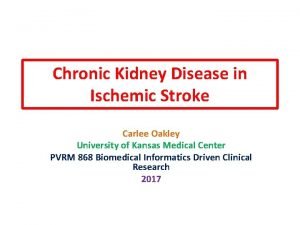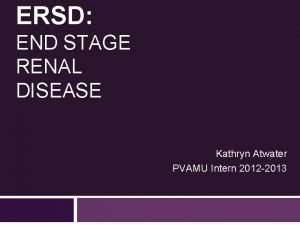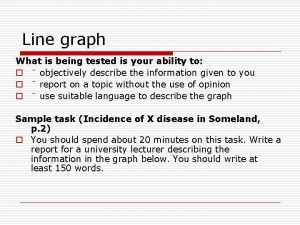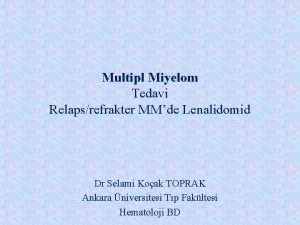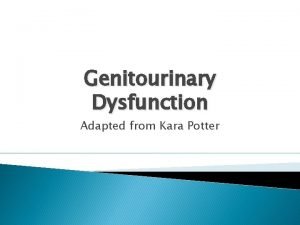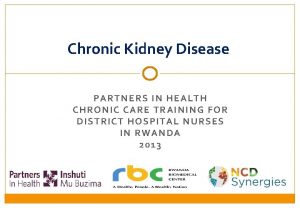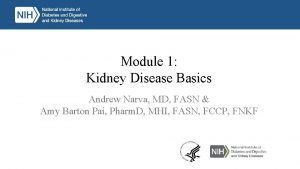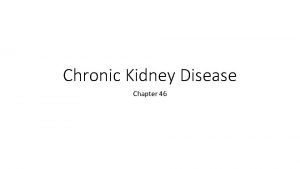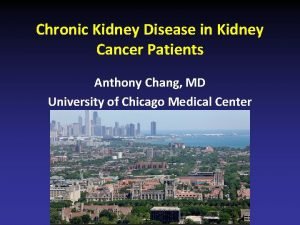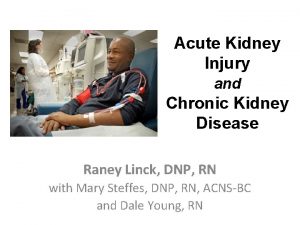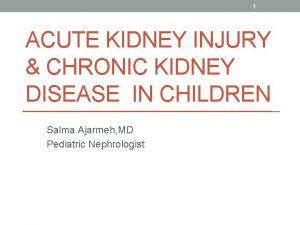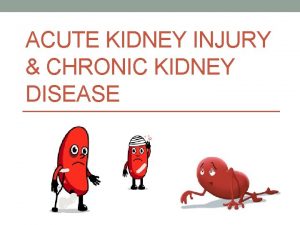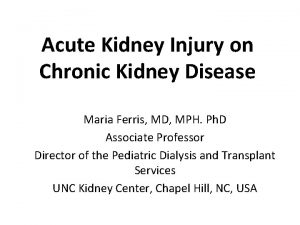Incidence of Cancer in Chronic Kidney Disease Jagadeesh










- Slides: 10

Incidence of Cancer in Chronic Kidney Disease Jagadeesh Puvvula, Pharm D, MPH, Scott Campbell, Phd, MBA, Apar Kishor Ganti, MD, MS, Ketki Tendulkar, MD VA Nebraska Western Iowa Health Care System and University Of Nebraska Medical Center

INTRODUCTION • Cancer leading cause of morbidity and mortality in the United States. • >15% of US adults are estimated to have Chronic Kidney disease (CKD). • Previous studies have shown an increased risk of certain cancers in dialysis patients. • Kidney dysfunction leads to retention of metabolic waste products and causes disruption of multiple pathways - to increase cancer risk. • Current evidence is less robust and not unanimous about the type and sitespecific cancer incidence. • In an attempt to clarify literature variability, we undertook this analysis of the risk of cancer across ranges of renal insufficiency at our cancer center.

METHODS • Adult patients (> 18 years) with a diagnosis of CKD who received care at our institution from 2008 – 2018 from UNMC clinical data warehouse (CDW). • CDW - monthly data extracts from the enterprise EHR, de-identified and managed using international data standards (SNOMED CT, ICD-10 -CM, LOINC and Rx. Norm); maintained in an i 2 b 2 database (Informatics from Integrating Biology and the Bedside). • Crude and age-adjusted incidence rate - based on the CKD patients who were eventually diagnosed with a primary malignancy. • We extracted cancer incidence information from CDC Wonder Database, to compare US, Nebraska and Omaha-Council Bluffs region with our sample (CKD patients). • Population estimates for Omaha region extracted from US Census Bureau 2010 Decennial Census data to calculate the age-adjusted incidence for the

RESULTS • We identified 20, 400 patients with CKD. • Of these, 813 developed an invasive malignancy. • The most common malignancies diagnosed were: digestive system (n=129), urinary tract (n=105), respiratory tract (n=96), melanoma and other invasive skin cancers (n=95) and hematologic malignancies (n=90). • Patients with CKD had a much higher incidence of cancer (3220/100, 000 population) as compared to the general population in Nebraska (645/100, 000 population). • Cancers that had the highest incidence as compared to the general population were hematologic malignancies (412. 6 vs. 18. 7/100, 000), skin cancer (412. 7 vs. 30. 6/100, 000) and urinary system (454. 8 vs. 54. 3/100, 000).

Classification All cancer cases Digestive system Urinary system Respiratory system Skin Leukemia Male genital system Breast Sarcoma, NOS Female genital system Oral cavity and Pharynx Neuroendocrine carcinoma, NOS Carcinoma in situ, NOS Endocrine system Other Genitourinary Cancers Bone and joint Brain and other nervous system Mesothelioma and soft tissue Frequency 813 129 105 96 95 90 87 66 38 30 18 11 10 10 9 4 2 2 Percent 14. 84 12. 08 11. 05 10. 93 10. 36 10. 01 7. 59 4. 37 3. 45 2. 07 1. 27 1. 15 1. 04 0. 46 0. 23 At risk 20400 20400 11240 20400 9160 20400 20400 Crude 5269. 61 632. 35 514. 71 470. 59 465. 69 441. 18 774. 02 323. 53 186. 27 147. 06 88. 24 53. 92 49. 02 44. 12 19. 61 9. 80

Age Standard distribution Cohort Cancer Population - standard population GI Urinary Respiratory Skin cancer Leukemia Age 18 - 59 240074 0. 78382 5108 2178. 98 245. 52 322. 24 214. 83 306. 90 60 - 69 33177 0. 10832 4192 578. 81 87. 85 77. 52 67. 18 62. 02 51. 68 70 - 79 18947 0. 06186 4933 318. 52 57. 68 36. 37 42. 64 38. 87 33. 86 80+ 14089 0. 045999 6167 143. 96 24. 61 18. 65 16. 41 14. 92 20. 14 Total 306287 1 20400 3220. 27 415. 67 454. 78 341. 06 422. 71 412. 58 Standard population estimates retrieved from US Census Bureau 2010 Decennial census for Omaha


DISCUSSION • Possible link between the chronic inflammatory microenvironment in CKD and cancer • Inflammatory pro-oxidant microenvironment in patients with reduced GFR, is thought to contribute to cancer development • CKD - immune dysfunction with alterations of the renin-angiotensin system, and endothelial abnormalities, may increase cancer risk • Commonly prescribed medications, such as anti-hypertensives and statins associated with higher cancer risk. • Uremic milieu with accumulation of indoxyl sulfate, p-cresyl sulfate, or nitric oxide - state of impaired DNA repair, nutritional deficiency, and accumulation of carcinogens. • The reason for the increased risk of cancer in patients with CKD needs to be studied further.

CONCLUSIONS • CKD patients have a significantly increased incidence of cancer. In our center-representative study we found a modestly higher cancer risk in individuals with CKD. • Detection bias and reverse causality may partly explain the higher risk of cancer during the first year of follow-up, but it is less likely to explain the higher risks in the long term. • Our findings may help healthcare policy makers develop appropriate guidelines for cancer screening and monitoring for patients with CKD given recent advances in cancer care.

: REFERENCES • https: //nccd. cdc. gov/ckd • Hong Xu, Kunihiro Matsushita, Guobin Su, Marco Trevisan, Johan Ärnlöv, Peter Barany, Bengt Lindholm, Carl-Gustaf Elinder, Mats Lambe and Juan-Jesus Carrero Estimated Glomerular Filtration Rate and the Risk of Cancer. CJASN April 2019 14: (4) 530 -539 • Wegman-Ostrosky T, Soto-Reyes E, Vidal-Millán S, Sánchez-Corona J. The renin-angiotensin system meets the hallmarks of cancer. J Renin Angiotensin Aldosterone Syst 16: 227– 233, 2015 • Lowrance WT, Ordoñez J, Udaltsova N, Russo P, Go AS. CKD and the risk of incident cancer. J Am Soc Nephrol 25: 2327– 2334, 2014 • Akchurin OM, Kaskel F. Update on inflammation in chronic kidney disease. Blood Purif 39: 84– 92, 2015 • Fernandes JV, Cobucci RN, Jatobá CA, Fernandes TA, de Azevedo JW, de Araújo JM. The role of the mediators of inflammation in cancer development. Pathol Oncol Res 21: 527– 534, 2015 • Franses JW, Drosu NC, Gibson WJ, Chitalia VC, Edelman ER. Dysfunctional endothelial cells directly stimulate cancer inflammation and metastasis. Int J Cancer 133: 1334– 1344, 2013 • Menck CF, Munford V. DNA repair diseases: What do they tell us about cancer and aging? Genet Mol Biol 37[Suppl]: 220– 233, 2014 • Cheng H, Wang L, Mollica M, Re AT, Wu S, Zuo L. Nitric oxide in cancer metastasis. Cancer Lett 353: 1– 7, 2014 • Bangalore S, Kumar S, Kjeldsen SE, Makani H, Grossman E, Wetterslev J, Gupta AK, Sever PS, Gluud C, Messerli FH. Antihypertensive drugs and risk of cancer: Network meta-analyses and trial sequential analyses of 324, 168 participants from randomised trials. Lancet Oncol 12: 65– 82, 2011
